|
| Author |
Message |
cluttonfred
Member
|
# Posted: 13 Jun 2019 11:58am
Reply
Hi, all. I am new to the forum but have been a fan of small houses and cabins for 30+ years. Recently, I have been daydreaming about building a small A-frame like this 18' x 24' one from David Stiles (see http://www.stilesdesigns.com/downloadable-shed-plans.html and attached images).
My question for the group is about insulation and rodent protection under floor for any cabin without a full foundation or slab but raised on piers or end walls like this, with the floor decking right on the joists and an open crawlspace. What's the best way to insulate the floor and keep out the critters?
Cheers,
Matthew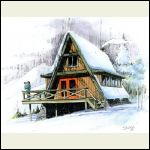
Stiles_Aframe_cabin.jpg
| 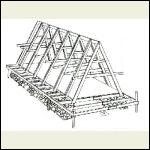
stiles_aframe_1.gif
|  |  |
|
|
Brettny
Member
|
# Posted: 13 Jun 2019 12:18pm
Reply
Spray foam and ply wood on the under side is best. Prob the most expensive though. Any insulation chould be protected with plywood no matter how you insulate.
|
|
silverwaterlady
Member
|
# Posted: 13 Jun 2019 01:13pm - Edited by: silverwaterlady
Reply
We used spray foam. It's worth every penny.
I thought I wanted an A frame until my husband talked me out of it. There is far to much wasted space. We made sure to put the roof at enough pitch and use steel roofing so the snow just slides off the roof.
We put a French drain in to handle the snow melt.
We didn't put up any snow guards. Nobody is there to get hit with a roof snow Avalanche.
|
|
cjm
Member
|
# Posted: 13 Jun 2019 01:52pm
Reply
I'm planning to do a version of this: https://www.buildingscience.com/documents/insights/bsi-031-building-in-extreme-cold
From bottom-up: floor joists, plywood, membrane, xps, subfloor
|
|
Atlincabin
Member
|
# Posted: 13 Jun 2019 02:10pm
Reply
Our cabin is on piers. For floor insulation we just put in rock wool (similar to fiberglass) and covered the bottom with 3/8" pressure-treated plywood. Of course a vapor barrier etc. on the warm (floor) side of this. We have not had any issues with rodents, but are far enough off the ground that porcupines etc. cannot stand on the ground and chew at the wood. Adding a layer of hardware cloth (better) or chicken wire (probably ok but bigger mesh size) over the bottom, outside the plywood, would eliminate any chance of the rodents chewing through the plywood.
|
|
SCSJeff
Member
|
# Posted: 13 Jun 2019 09:41pm - Edited by: SCSJeff
Reply
I'm still debating what to do under our place...
We don't have a finished floor down yet and I keep going back and forth between just sheet vinyl and something else. But, I worry about trapping moisture between the vinyl and whatever I end up doing underneath (if it's not vapor permeable)..
Atlincabin, your solution is one option for me. But, I then worry about creating a home for carpenter ants that I can't get to. (We've already had them move in during construction and it took me a month or two after it was done to find the nest in the header over the french doors  ) )
|
|
cluttonfred
Member
|
# Posted: 14 Jun 2019 07:34am - Edited by: cluttonfred
Reply
Thanks, all. I am not looking at arctic temperatures like CJM, though northern New England is a possibility.
Right now I am thinking for the floor, inside to outside:
1. tongue-and-groove flooring
2. vapor barrier
3. loose or batten insulation between the joists
4. 1-2" rigid foam below the joists to reduce thermal bridging, edges sealed with spray foam
5. OSB
6. hardware cloth
End walls would be similar, inside to outside:
1. drywall/paneling
2. vapor barrier
3. batten insulation between the framing
4. 1-2" rigid foam
5. house wrap
6. siding
Roof (which is most of an A-frame) would also be similar but with much thicker rigid foam to make up for no batten insulation (roof decking and joists visible from inside), so inside to outside:
1. tongue-and-grove roof decking
2. vapor barrier
3. 4" or more of rigid foam
4. OSB screwed to the decking through the foam,
5. Underlayment
6. Roofing (possibly corrugated metal or Ondura)
Cheers,
Matthew
|
|
creeky
Member
|
# Posted: 14 Jun 2019 08:10am
Reply
Quoting: SCSJeff carpenter ants
The bane of my small building existence. I do battle every spring. This year its later in the season that the carpenter ants have appeared. But bait traps pre-deployed. Wish me luck. I've also tried cinnamon powder around the exterior posts. Apparently they can't read their trail scent and so don't go there.
But for anyone building with rigid foam. Beware.
cf, not really knowing where you are, those assemblies look good.
|
|
|
cjm
Member
|
# Posted: 14 Jun 2019 09:55am
Reply
Matthew - that's similar to what I'm thinking (not the full arctic setup). I'm thinking 4" XPS on roof, 2.5" on walls, 1.5" on the floor... no batten insulation though, just floor joists open to below so no need for hardware cloth. I've debated doing more than just 1.5 in the floor but I'm only going to be there for a night or two every few weeks.
|
|
Just
Member
|
# Posted: 14 Jun 2019 11:51am
Reply
Carpenter Ants
I have had good luck with sprinkling some Borax around the foundation every few weeks .
|
|
SCSJeff
Member
|
# Posted: 14 Jun 2019 12:44pm
Reply
Since my infestation & a second time where they were everywhere going up/down under the siding, I started sprinkling these two products around the foundation every time I'm up from spring to fall:
https://www.amazon.com/gp/product/B003EAP02G/ref=ppx_yo_dt_b_asin_title_o09_s00?ie=UT F8&psc=1
https://www.amazon.com/gp/product/B00461HCLO/ref=ppx_yo_dt_b_asin_title_o00_s00?ie=UT F8&psc=1
Haven't had a problem since (in the cabin). This spring they were all over my shed. So I have to start treating that too...
|
|
Lippy667
Member
|
# Posted: 14 Jun 2019 04:25pm
Reply
Another good one for carpenter ants is the Maxforce bait gel. Took care of the nest that moved into my house when the dumb plumber didn't seal the hole he drilled for the sump pump drain. Saw a line of ants coming up from the swamp when we got a good rain, right up the pipe and into the house. Took a few days, no more ants in the house. I also bought the powder, but they always seemed to go for the gel instead.
|
|
cluttonfred
Member
|
# Posted: 14 Jun 2019 04:45pm
Reply
My understanding is that a raised floor on piers or end walls is more like a wall than a floor in traditional construction over a foundation. I think it would be better to do a vapor barrier under the floor decking and the foam under the joists even if you don't fill the spaces between the joists with insulation. I could see going with fine screen for bugs and heavy hardware cloth for critters under the foam and eliminating the OSB under the joists, which might actually help the floor "breath" better.
Quoting: cjm Matthew - that's similar to what I'm thinking (not the full arctic setup). I'm thinking 4" XPS on roof, 2.5" on walls, 1.5" on the floor... no batten insulation though, just floor joists open to below so no need for hardware cloth. I've debated doing more than just 1.5 in the floor but I'm only going to be there for a night or two every few weeks.
|
|
ChuckDynasty
Member
|
# Posted: 14 Jun 2019 06:39pm - Edited by: ChuckDynasty
Reply
Quoting: Just Carpenter Ants I have had good luck with sprinkling some Borax around the foundation every few weeks .
I have a shed that had carpenter ants for years. I put Borax around the inside walls of the shed. This is the second summer with no sign of them after one generous treatment.
|
|
cjm
Member
|
# Posted: 14 Jun 2019 11:07pm - Edited by: cjm
Reply
Quoting: cluttonfred My understanding is that a raised floor on piers or end walls is more like a wall than a floor in traditional construction over a foundation.
Totally agree on the idea that it is more like a wall and totally agree that typical construction has the vapor barrier as you say. I'm not really planning to do the typical wall construction though; e.g. in that arctic house, all the insulation is sandwiched above the floor joists. Lstiburek from Building Science also insists that walls shouldn't breath and that the wall/floor/roof should dry in from the inside of the control layers and out from the outside of the control layers.
In any case though, I've also thought a lot about putting the foam on the outside of the floor joists. Like you say, this would match how my wall will be constructed. However, I can't think of a way that I'm happy with to deal with the intersection of the floor joists and the girders.
(I'll also say that my knowledge on this just comes from a lot of reading online - I really like the stuff on buildingscience.com. I add this because I always wonder on forums who actually knows what they are talking about - so just putting it out there that I don't claim to have any expertise  ) )
|
|
cluttonfred
Member
|
# Posted: 15 Jun 2019 03:38am - Edited by: cluttonfred
Reply
Same here on the personal expertise, I am just summing up what I have read and trying to figure how to learn from others that have tackled similar challenges. The only A-frame or any other “cabin†I have ever built before was an uninsulated 8’ x 8’ shed/playhouse so I have a lot to learn.
PS—That site you mentioned is a great resource. This article on crawlspaces suggests I am on the right track but I could simplify. It actually recommends spray foam for open pier construction but that does not appeal to me.
https://www.buildingscience.com/documents/insights/bsi-009-new-light-in-crawlspaces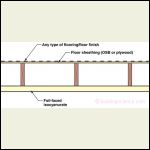
Polyiso under joists
| 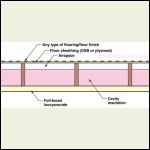
Polyiso and fiberglass
| 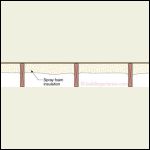
Partial spray foam
| 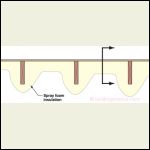
Full spray foam
|
|
|
creeky
Member
|
# Posted: 15 Jun 2019 10:10am - Edited by: creeky
Reply
While I am a long time buildingscience reader and devotee; I would worry about those polyiso floors in pics one and two.
I helped a buddy redo a floor to an extension added on to his house (on piers). The floor was insulated with batt insulation and the vapour barrier was tacked to the bottom of the joists. 3/4" ply as the floor/subfloor.
Looked good. But some of the floor was rotting and when we pulled up the ply, the pink insulation was sagging and held in place only by the plastic sheet of vapour barrier (6 mil bog standard for the time).
When we tried to pull the insulation up. It came up soaked in water. And in areas where the insulation hadn't sagged. Huge lakes of water were trapped on top of the plastic.
Those polyiso sheets in those pics look like they'd collect similar swimming pools of water. Not sure I like that.
What I've done is put sheets of polyiso (like pic 3: partial) up against the floor. Then I filled the cracks with spray foam (just cheaper). I then (cold climate) filled the joist bays with roxul (now called rock wool).
That seems to have worked.
Thx for tips on Borax. Gotta box of that somewhere. And I bought Gel ant bait last year. I was wondering why the ants seemed fewer this year. I think I will buy more of those too.
I was wondering, the RVs use some kind of dark black/grey material underneath. Anybody know what that was? I found a 80s trailer. Bug and mouse free. Thought that stuff must be pretty good.
|
|
cluttonfred
Member
|
# Posted: 15 Jun 2019 02:11pm
Reply
Thanks, Creeky. Yes, I can see where the foam could be become a moisture trap, though I can also see how the uninsulated floor joists could become thermal bridges making cold spots on the floor and a path for moisture to follow. This is a puzzling issue as every time I do some digging I seem to find different answers. Another solution might be to put down ply or OSB subfloor, a layer of foam taped and sealed as a vapor barrier, and then tongue and groove flooring on top nailed right through the foam.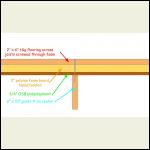
foam under flooring sketch
|  |  |  |
|
|
Atlincabin
Member
|
# Posted: 15 Jun 2019 05:48pm
Reply
Yes, you need the vapor barrier on the warm side of the system, i.e., just below the subfloor or on top of the subfloor. I wouldn't worry about thermal bridging on a 2x10 floor joist. You might also consider closer joist spacing for a less bouncy floor, especially if the span is 18 feet. Or going to at least a 2x12 or 4x10. Look at some lumber deflection tables online to determine how much deflection you may get based on the lumber size, span, and live load.
|
|
cluttonfred
Member
|
# Posted: 15 Jun 2019 07:29pm - Edited by: cluttonfred
Reply
With what is essentially 1-1/2" solid wood decking (2 x 6 tongue and groove) I am not too worried about 4' joist spacing. I was thinking that the OSB is only there to avoid crushing the foam at the joists and provide a pest barrier, but another approach might be to add some 2 x 4 blocking between the joists and hardware cloth underneath.
You could also bond the decking to the polyiso and the polyiso to the OSB to basically create a sandwich, kind of like building your own structural insulated panel (SIP) in place. In that case I think you could probably get away with 1 x 6 flooring instead of 2 x 6 but it would be a pain if you every had to pull up the flooring for some reason.
I wonder, has anyone ever tried to make your own DIY SIPs? I have seen 2" polyiso foam full sheets for under $40, so adding a couple of OSB sheets and the right adhesive ought to make nice rigid panels for about $60 each.
|
|
HiLonesome
Member
|
# Posted: 16 Jun 2019 11:38am
Reply
Hi all.
What I did, moving from the bottom up, was:
2x10 treated floor joists
2x2 treated ledgers
Roll tin (steel) onto the ledgers and nail (comes in right width at Home Depot)
Pink foam onto the tin
Spray foam to seal cracks
Regular 3/4 plywood subfloor
Floor dance
Laminate flooring
Area rug.
A pic is worth a thousand words. Bullet proof for all shapes and sized of critters.
|
|
cluttonfred
Member
|
# Posted: 17 Jun 2019 03:05am
Reply
That steel flashing on 2x2 ledgers is a great idea.
|
|
Princelake
Member
|
# Posted: 17 Jun 2019 07:07am
Reply
I had that exact idea for the tin but I priced rolled aluminum like just buying a couple extra rolls when I do the fascia and capping it was quite pricey but I would think tin is cheaper. I also thought to just out it across the bottom of the joists so no chance of rodents chewing on it. Any issues with condensation?
|
|
Brettny
Member
|
# Posted: 17 Jun 2019 08:27am
Reply
If i remember right aluminum rolls are $50 for a 24inx50ft roll. That does get pricy quick and is really there just to keep animals out. There are cheaper ways to accomplish this.
|
|
cluttonfred
Member
|
# Posted: 17 Jun 2019 09:25am - Edited by: cluttonfred
Reply
What would you suggest Brettny? I have not come across a substantially cheaper option than galvanized (not aluminum) flashing. Something like heavy gauge 1/2" hardware cloth, while a little cheaper per square foot, would not provide as much protection.
I wonder if cement backer board dropped between the joists on 2x2 supports would an alternative worth considering?
|
|
Atlincabin
Member
|
# Posted: 17 Jun 2019 10:26am
Reply
1/4" hardware cloth will keep out all the critters except bugs. With regard to condensation on roll aluminum/tin, if your vapor barrier is installed properly, that "should" not happen.
|
|
Brettny
Member
|
# Posted: 17 Jun 2019 02:47pm
Reply
Plywood would be my choice. Will seal better
|
|
SCSJeff
Member
|
# Posted: 17 Jun 2019 03:27pm
Reply
Correct me if I'm wrong...
If I do vinyl flooring inside (either sheet or plank), wouldn't that act as a vapor barrier? (ie: completely impermeable)
And, if so, don't I need to make sure whatever is on bottom, to keep critters/bugs out, must be able to breath?
I think Plywood would count as semi-permeable, but, plywood is pretty expensive now and would be a pain laying on my back installing it 
Is hardware cloth cheaper? Can I get it small enough to keep carpenter ants out?
|
|
Brettny
Member
|
# Posted: 17 Jun 2019 04:11pm
Reply
Right now plywood is the cheapest i have seen it in 8 yrs. I think it has something to do with a slow start on hurricane season. Not saying hardwarw cloth is a bad idea its just that it dosnt keep bees or other insects out.
|
|
SCSJeff
Member
|
# Posted: 17 Jun 2019 10:35pm
Reply
Well...
I don't "think" bees will be a problem if the joists are filled with roxul, but maybe ants still???? (I know they love fiberglass for nests)
|
|
|

